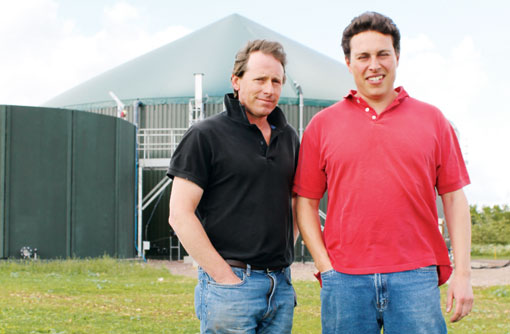Joint venture is key to AD

Of all the forms of renewable energy, anaerobic digestion probably presents the greatest challenge for poultry farmers.
The high nitrogen content of chicken litter means it can only be added to the AD feedstock in limited quantities, or it will kill the bacteria in the digester and destroy the process.
But Jeremy Iles, who produces 170,000 standard broilers for Hook 2 Sisters on his farm near Cirencester, Gloucestershire, has overcome that problem by forming a joint venture with neighbouring pig farmer James Hart, combining the manure from both of their enterprises.
“We’ve known each other for many years, and already share farm our combined 600ha of arable land,” he told Poultry World.
The AD plant was self-built at Mr Hart’s pig unit in the second half of 2010, and was fired up for the first time in April. The feedstock is made up of 5t a day of chicken litter, 40t a day of pig slurry, 4t a day of farmyard manure and 4t a day of home-grown maize silage. “A 3,000t cow’s stomach” is how Mr Hart describes it.
The methane is used to run a 350kW generator, though the maximum that can be delivered to the national grid from the site is 250kW. “I also use an average of 32kW on the pig farm, while the heat from the generator is used to warm my pig manager’s house,” said Mr Hart.
Unfortunately, Mr Iles’s poultry farm is too far away to use any of the heat or electricity from the AD plant. “But at some point we could run a gas line to my sheds for heat and power,” he said.
Total cost of the project is put at £1.2m, including £60,000 for the grid connection. This was partly offset by a £430,000 RDPE grant, awarded by the South West RDA. This innovations fund was set up to promote European investment in new technologies in rural areas. Because of the grant, they are not able to claim the Feed-in Tariff, worth 13p/kWh, but do receive a Renewable Obligation Certificate payment, worth between 9p and 10p/kWh.
Combined with electricity sales of 5.4p/kWh, the income for the plant comes to an estimated £350,000 a year. After deducting other costs, such as interest, maize production, maintenance and labour, (about two hours a day), Messrs Iles and Hart are anticipating that the project will have paid for itself within five to seven years.
On top of that, there is also the free heat, as well as a two-thirds reduction in the fertiliser requirement for the arable operation.
“The finances of anaerobic digestion look very exciting,” said Mr Hart, and it is an enterprise that fits very well with the existing farm enterprises.
With this motivation, they can envisage expanding the site to make better use of the heat with a plant that could supply heat and electricity to the local school and housing.
